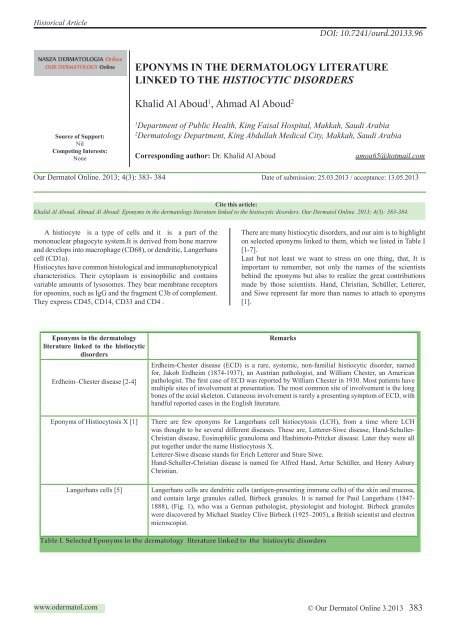EPONYMS IN THE DERMATOLOGY LITERATURE LINKED TO THE ...
EPONYMS IN THE DERMATOLOGY LITERATURE LINKED TO THE ...
EPONYMS IN THE DERMATOLOGY LITERATURE LINKED TO THE ...
Create successful ePaper yourself
Turn your PDF publications into a flip-book with our unique Google optimized e-Paper software.
Historical Article<br />
DOI: 10.7241/ourd.20133.96<br />
<strong>EPONYMS</strong> <strong>IN</strong> <strong>THE</strong> <strong>DERMA<strong>TO</strong>LOGY</strong> <strong>LITERATURE</strong><br />
L<strong>IN</strong>KED <strong>TO</strong> <strong>THE</strong> HISTIOCYTIC DISORDERS<br />
Khalid Al Aboud 1 , Ahmad Al Aboud 2<br />
Source of Support:<br />
Nil<br />
Competing Interests:<br />
None<br />
1<br />
Department of Public Health, King Faisal Hospital, Makkah, Saudi Arabia<br />
2<br />
Dermatology Department, King Abdullah Medical City, Makkah, Saudi Arabia<br />
Corresponding author: Dr. Khalid Al Aboud<br />
amoa65@hotmail.com<br />
Our Dermatol Online. 2013; 4(3): 383- 384 Date of submission: 25.03.2013 / acceptance: 13.05.2013<br />
Cite this article:<br />
Khalid Al Aboud, Ahmad Al Aboud: Eponyms in the dermatology literature linked to the histiocytic disorders. Our Dermatol Online. 2013; 4(3): 383-384.<br />
A histiocyte is a type of cells and it is a part of the<br />
mononuclear phagocyte system.It is derived from bone marrow<br />
and develops into macrophage (CD68), or dendritic, Langerhans<br />
cell (CD1a).<br />
Histiocytes have common histological and immunophenotypical<br />
characteristics. Their cytoplasm is eosinophilic and contains<br />
variable amounts of lysosomes. They bear membrane receptors<br />
for opsonins, such as IgG and the fragment C3b of complement.<br />
They express CD45, CD14, CD33 and CD4 .<br />
There are many histiocytic disorders, and our aim is to highlight<br />
on selected eponyms linked to them, which we listed in Table I<br />
[1-7].<br />
Last but not least we want to stress on one thing, that, It is<br />
important to remember, not only the names of the scientists<br />
behind the eponyms but also to realize the great contributions<br />
made by those scientists. Hand, Christian, Schüller, Letterer,<br />
and Siwe represent far more than names to attach to eponyms<br />
[1].<br />
Eponyms in the dermatology<br />
literature linked to the histiocytic<br />
disorders<br />
Erdheim–Chester disease [2-4]<br />
Eponyms of Histiocytosis X [1]<br />
Langerhans cells [5]<br />
Remarks<br />
Erdheim-Chester disease (ECD) is a rare, systemic, non-familial histiocytic disorder, named<br />
for, Jakob Erdheim (1874-1937), an Austrian pathologist, and William Chester, an American<br />
pathologist. The first case of ECD was reported by William Chester in 1930. Most patients have<br />
multiple sites of involvement at presentation. The most common site of involvement is the long<br />
bones of the axial skeleton. Cutaneous involvement is rarely a presenting symptom of ECD, with<br />
handful reported cases in the English literature.<br />
There are few eponyms for Langerhans cell histiocytosis (LCH), from a time where LCH<br />
was thought to be several different diseases. These are, Letterer-Siwe disease, Hand-Schuller-<br />
Christian disease, Eosinophilic granuloma and Hashimoto-Pritzker disease. Later they were all<br />
put together under the name Histiocytosis X.<br />
Letterer-Siwe disease stands for Erich Letterer and Sture Siwe.<br />
Hand-Schuller-Christian disease is named for Alfred Hand, Artur Schüller, and Henry Asbury<br />
Christian.<br />
Langerhans cells are dendritic cells (antigen-presenting immune cells) of the skin and mucosa,<br />
and contain large granules called, Birbeck granules. It is named for Paul Langerhans (1847-<br />
1888), (Fig. 1), who was a German pathologist, physiologist and biologist. Birbeck granules<br />
were discovered by Michael Stanley Clive Birbeck (1925–2005), a British scientist and electron<br />
microscopist.<br />
Table I. Selected Eponyms in the dermatology literature linked to the histiocytic disorders<br />
www.odermatol.com<br />
© Our Dermatol Online 3.2013 383
Figure 1. Paul Langerhans (1847-1888)<br />
Figure 2. Juan Rosai<br />
Figure 3. Ronald F. Dorfman<br />
(1923-2012)<br />
Eponyms in the dermatology<br />
literature linked to the histiocytic<br />
disorders<br />
Rosai–Dorfman disease [6,7]<br />
Remarks<br />
Rosai–Dorfman disease, also known as sinus histiocytosis with massive<br />
lymphadenopathy, is a rare disorder of unknown etiology that is characterized by<br />
abundant histiocytes in the lymph nodes throughout the body. Cutaneous<br />
involvement may occur. This condition has been named afterJuan Rosai and Ronald F.<br />
Dorfman.Juan Rosai, (Fig. 2), is an Italian-born American physician who has contributed to<br />
clinical research in the subspecialty of surgical pathology.He was born in 1940. Ronald F.<br />
Dorfman (1923-2012), (Fig. 3), was a Professor of Pathology at Stanford Hospital.<br />
An alternative eponym of this condition is known as Destombes-Rosai-Dorfman<br />
syndrome, part of which is named afterbPierre-Paul Louis Lucien Destombes, a French<br />
pathologist, Born 1912.<br />
Table I. Selected Eponyms in the dermatology literature linked to the histiocytic disorders (continued)<br />
REFERENCES<br />
1. Komp DM: Historical perspectives of Langerhans cell histiocytosis.<br />
Hematol Oncol Clin North Am. 1987;1:9-21.<br />
2. Skinner M, Briant M, Morgan MB: Erdheim-Chester disease:<br />
a histiocytic disorder more than skin deep. Am J Dermatopathol.<br />
2011;33:24-6.<br />
3. Volpicelli ER, Doyle L, Annes JP, Murray MF, Jacobsen E, Murphy<br />
GF, et al: Erdheim-Chester disease presenting with cutaneous<br />
involvement: a case report and literature review. J Cutan Pathol.<br />
2011;38:280-5.<br />
4. Romm S: Jakob Erdheim. Eminent pathologist of Vienna. Am J<br />
Dermatopathol. 1987;9:447-50.<br />
5.Holubar K. [Paul Wilhelm Heinrich Langerhans (1847-1888).<br />
In memory of the centenary of his death 20 July 1988]. Wien Klin<br />
Wochenschr. 1988;100:514-9.<br />
6.Rosai J, Dorfman RF: Sinus histiocytosis with massive<br />
lymphadenopathy. A newly recognized benign clinicopathological<br />
entity. Arch Pathol. 1969;87:63-70.<br />
7. Brenn T, Calonje E, Granter SR, Leonard N, Grayson W, Fletcher<br />
CD, et al: Cutaneous Rosai-Dorfman disease is a distinct clinical<br />
entity. Am J Dermatopathol. 2002;24:385-391.<br />
Copyright by Khalid Al Aboud, et al. This is an open access article distributed under the terms of the Creative Commons Attribution License, which<br />
permits unrestricted use, distribution, and reproduction in any medium, provided the original author and source are credited.<br />
384 © Our Dermatol Online 3.2013
















